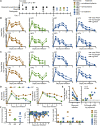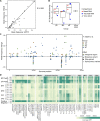SARS-CoV-2 Infection of Rhesus Macaques Treated Early with Human COVID-19 Convalescent Plasma
- PMID: 34817208
- PMCID: PMC8612156
- DOI: 10.1128/Spectrum.01397-21
SARS-CoV-2 Infection of Rhesus Macaques Treated Early with Human COVID-19 Convalescent Plasma
Abstract
Human clinical studies investigating use of convalescent plasma (CP) for treatment of coronavirus disease 2019 (COVID-19) have produced conflicting results. Outcomes in these studies may vary at least partly due to different timing of CP administration relative to symptom onset. The mechanisms of action of CP include neutralizing antibodies but may extend beyond virus neutralization to include normalization of blood clotting and dampening of inflammation. Unresolved questions include the minimum therapeutic titer in the CP units or CP recipient as well as the optimal timing of administration. Here, we show that treatment of macaques with CP within 24 h of infection does not reduce viral shedding in nasal or lung secretions compared to controls and does not detectably improve any clinical endpoint. We also demonstrate that CP administration does not impact viral sequence diversity in vivo, although the selection of a viral sequence variant in both macaques receiving normal human plasma was suggestive of immune pressure. Our results suggest that CP, administered to medium titers, has limited efficacy, even when given very early after infection. Our findings also contribute information important for the continued development of the nonhuman primate model of COVID-19. These results should inform interpretation of clinical studies of CP in addition to providing insights useful for developing other passive immunotherapies and vaccine strategies. IMPORTANCE Antiviral treatment options for severe acute respiratory syndrome coronavirus 2 (SARS-CoV-2) remain very limited. One treatment that was explored beginning early in the pandemic (and that is likely to be tested early in future pandemics) is plasma collected from people who have recovered from coronavirus disease 2019 (COVID-19), known as convalescent plasma (CP). We tested if CP reduces viral shedding or disease in a nonhuman primate model. Our results demonstrate that administration of CP 1 day after SARS-CoV-2 infection had no significant impact on viral loads, clinical disease, or sequence diversity, although treatment with normal human plasma resulted in selection of a specific viral variant. Our results demonstrate that passive immunization with CP, even during early infection, provided no significant benefit in a nonhuman primate model of SARS-CoV-2 infection.
Keywords: COVID-19; SARS-CoV-2; animal models of infectious diseases; convalescent plasma; microbial pathogenesis; nonhuman primate; passive immunization; virology.
Figures




Similar articles
-
Convalescent plasma - Is it useful for treating SARS Co-V2 infection?Indian J Med Microbiol. 2020 Jul-Dec;38(3 & 4):252-260. doi: 10.4103/ijmm.IJMM_20_358. Indian J Med Microbiol. 2020. PMID: 33154232 Free PMC article. Review.
-
SARS-CoV-2-specific humoral and cellular immunity in two renal transplants and two hemodialysis patients treated with convalescent plasma.J Med Virol. 2021 May;93(5):3047-3054. doi: 10.1002/jmv.26840. Epub 2021 Feb 9. J Med Virol. 2021. PMID: 33527424 Free PMC article.
-
Functional convalescent plasma antibodies and pre-infusion titers shape the early severe COVID-19 immune response.Nat Commun. 2021 Nov 25;12(1):6853. doi: 10.1038/s41467-021-27201-y. Nat Commun. 2021. PMID: 34824251 Free PMC article.
-
Genetic barrier to resistance: a critical parameter for efficacy of neutralizing monoclonal antibodies against SARS-CoV-2 in a nonhuman primate model.J Virol. 2024 Jul 23;98(7):e0062824. doi: 10.1128/jvi.00628-24. Epub 2024 Jun 20. J Virol. 2024. PMID: 38899895 Free PMC article.
-
Treatment of COVID-19 with convalescent plasma: lessons from past coronavirus outbreaks.Clin Microbiol Infect. 2020 Oct;26(10):1436-1446. doi: 10.1016/j.cmi.2020.08.005. Epub 2020 Aug 11. Clin Microbiol Infect. 2020. PMID: 32791241 Free PMC article. Review.
Cited by
-
Spike protein of SARS-CoV-2 variants: a brief review and practical implications.Braz J Microbiol. 2022 Sep;53(3):1133-1157. doi: 10.1007/s42770-022-00743-z. Epub 2022 Apr 9. Braz J Microbiol. 2022. PMID: 35397075 Free PMC article. Review.
-
COVID-19 Convalescent Plasma and Clinical Trials: Understanding Conflicting Outcomes.Clin Microbiol Rev. 2022 Sep 21;35(3):e0020021. doi: 10.1128/cmr.00200-21. Epub 2022 Mar 9. Clin Microbiol Rev. 2022. PMID: 35262370 Free PMC article. Review.
-
Estimates of actual and potential lives saved in the United States from the use of COVID-19 convalescent plasma.Proc Natl Acad Sci U S A. 2024 Oct 8;121(41):e2414957121. doi: 10.1073/pnas.2414957121. Epub 2024 Oct 1. Proc Natl Acad Sci U S A. 2024. PMID: 39352932 Free PMC article.
-
Vaccine-Boosted CCP Decreases Virus Replication and Hastens Resolution of Infection Despite Transiently Enhancing Disease in SARS-CoV-2-Infected Hamsters.J Infect Dis. 2024 Jun 14;229(6):1702-1710. doi: 10.1093/infdis/jiad568. J Infect Dis. 2024. PMID: 38213276 Free PMC article.
-
Early post-infection treatment of SARS-CoV-2 infected macaques with human convalescent plasma with high neutralizing activity had no antiviral effects but moderately reduced lung inflammation.PLoS Pathog. 2022 Apr 20;18(4):e1009925. doi: 10.1371/journal.ppat.1009925. eCollection 2022 Apr. PLoS Pathog. 2022. PMID: 35443018 Free PMC article.
References
-
- Richardson S, Hirsch JS, Narasimhan M, Crawford JM, McGinn T, Davidson KW, the Northwell COVID-19 Research Consortium, Barnaby DP, Becker LB, Chelico JD, Cohen SL, Cookingham J, Coppa K, Diefenbach MA, Dominello AJ, Duer-Hefele J, Falzon L, Gitlin J, Hajizadeh N, Harvin TG, Hirschwerk DA, Kim EJ, Kozel ZM, Marrast LM, Mogavero JN, Osorio GA, Qiu M, Zanos TP. 2020. Presenting characteristics, comorbidities, and outcomes among 5700 patients hospitalized with COVID-19 in the New York City area. JAMA 323:2052–2059. doi:10.1001/jama.2020.6775. - DOI - PMC - PubMed
-
- Poletti P, Tirani M, Cereda D, Trentini F, Guzzetta G, Sabatino G, Marziano V, Castrofino A, Grosso F, Del Castillo G, Piccarreta R, Andreassi A, Melegaro A, Gramegna M, Ajelli M, Merler S, ATS Lombardy COVID-19 Task Force. 2021. Association of age with likelihood of developing symptoms and critical disease among close contacts exposed to patients with confirmed SARS-CoV-2 infection in Italy. JAMA Netw Open 4:e211085. doi:10.1001/jamanetworkopen.2021.1085. - DOI - PMC - PubMed
-
- Wölfel R, Corman VM, Guggemos W, Seilmaier M, Zange S, Müller MA, Niemeyer D, Jones TC, Vollmar P, Rothe C, Hoelscher M, Bleicker T, Brünink S, Schneider J, Ehmann R, Zwirglmaier K, Drosten C, Wendtner C. 2020. Virological assessment of hospitalized patients with COVID-2019. Nature 581:465–469. doi:10.1038/s41586-020-2196-x. - DOI - PubMed
-
- Wang Y, Zhang L, Sang L, Ye F, Ruan S, Zhong B, Song T, Alshukairi AN, Chen R, Zhang Z, Gan M, Zhu A, Huang Y, Luo L, Mok CKP, Al Gethamy MM, Tan H, Li Z, Huang X, Li F, Sun J, Zhang Y, Wen L, Li Y, Chen Z, Zhuang Z, Zhuo J, Chen C, Kuang L, Wang J, Lv H, Jiang Y, Li M, Lin Y, Deng Y, Tang L, Liang J, Huang J, Perlman S, Zhong N, Zhao J, Malik Peiris JS, Li Y, Zhao J. 2020. Kinetics of viral load and antibody response in relation to COVID-19 severity. J Clin Invest 130:5235–5244. doi:10.1172/JCI138759. - DOI - PMC - PubMed
-
- Pairo-Castineira E, Clohisey S, Klaric L, Bretherick AD, Rawlik K, Pasko D, Walker S, Parkinson N, Fourman MH, Russell CD, Furniss J, Richmond A, Gountouna E, Wrobel N, Harrison D, Wang B, Wu Y, Meynert A, Griffiths F, Oosthuyzen W, Kousathanas A, Moutsianas L, Yang Z, Zhai R, Zheng C, Grimes G, Beale R, Millar J, Shih B, Keating S, Zechner M, Haley C, Porteous DJ, Hayward C, Yang J, Knight J, Summers C, Shankar-Hari M, Klenerman P, Turtle L, Ho A, Moore SC, Hinds C, Horby P, Nichol A, Maslove D, Ling L, McAuley D, Montgomery H, Walsh T, et al. . 2021. Genetic mechanisms of critical illness in COVID-19. Nature 591:92–98. doi:10.1038/s41586-020-03065-y. - DOI - PubMed
Publication types
MeSH terms
Substances
Grants and funding
LinkOut - more resources
Full Text Sources
Medical
Miscellaneous

